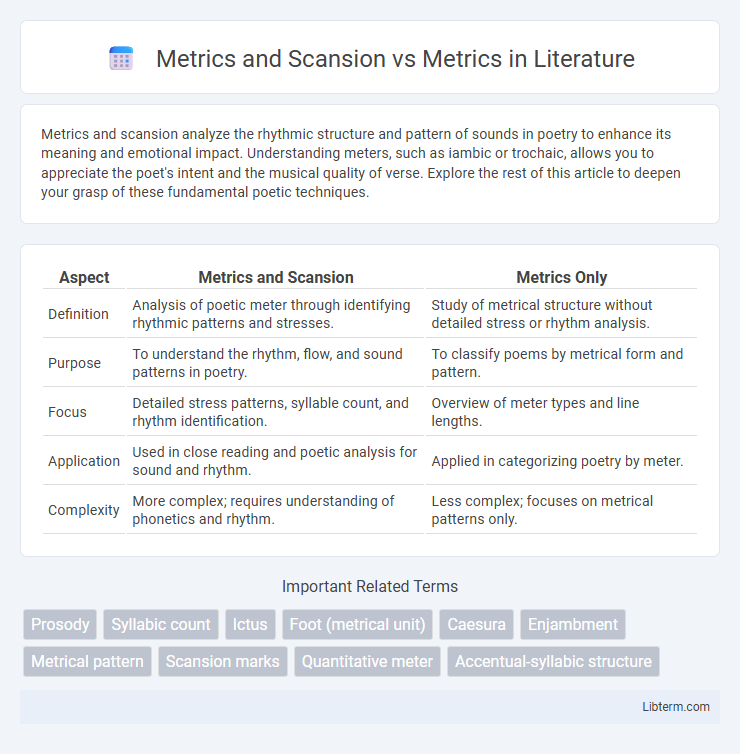Metrics and scansion analyze the rhythmic structure and pattern of sounds in poetry to enhance its meaning and emotional impact. Understanding meters, such as iambic or trochaic, allows you to appreciate the poet's intent and the musical quality of verse. Explore the rest of this article to deepen your grasp of these fundamental poetic techniques.
Table of Comparison
| Aspect | Metrics and Scansion | Metrics Only |
|---|---|---|
| Definition | Analysis of poetic meter through identifying rhythmic patterns and stresses. | Study of metrical structure without detailed stress or rhythm analysis. |
| Purpose | To understand the rhythm, flow, and sound patterns in poetry. | To classify poems by metrical form and pattern. |
| Focus | Detailed stress patterns, syllable count, and rhythm identification. | Overview of meter types and line lengths. |
| Application | Used in close reading and poetic analysis for sound and rhythm. | Applied in categorizing poetry by meter. |
| Complexity | More complex; requires understanding of phonetics and rhythm. | Less complex; focuses on metrical patterns only. |
Introduction to Metrics and Scansion
Metrics refers to the systematic study of poetic meter, analyzing the rhythmic structure of verse through patterns of stressed and unstressed syllables. Scansion is the method used within metrics to visually mark these stresses and breaks in a poem, facilitating the identification of specific metrical feet such as iambs, trochees, and dactyls. Understanding both metrics and scansion is essential for appreciating the formal rhythm and sound patterns that contribute to a poem's overall aesthetic and emotional impact.
Defining Metrics in Poetry
Defining metrics in poetry involves identifying the rhythmic structure created by patterns of stressed and unstressed syllables within a verse. Metrics analyze the quantitative length or qualitative accentuation variables that form the foundation of poetic meter, enabling consistent rhythm and flow. Unlike scansion, which is the process of marking these patterns in a poem, metrics provide the theoretical framework for understanding how these patterns establish poetic form and cadence.
The Role of Scansion in Analyzing Verse
Scansion plays a crucial role in analyzing verse by breaking down the rhythmic structure into patterns of stressed and unstressed syllables, helping to identify the meter of a poem. While metrics refers broadly to the study of verse forms and their rhythmic organization, scansion provides the detailed method to measure and interpret these rhythmic patterns. This analysis enhances the understanding of a poem's emotional impact and formal design by revealing subtle variations and consistent beats within the verse.
Key Differences: Metrics vs Metrics and Scansion
Metrics analyzes the quantitative structure of poetry, measuring stress patterns, syllable count, and rhythm to define the poem's form, while scansion focuses on the practical application of marking and interpreting these patterns within a specific poem. Key differences lie in metrics as the theoretical framework of poetic meter, whereas scansion represents the act of dissecting individual lines to reveal their metrical composition. Understanding metrics provides fundamental rules and classifications, but scansion helps in visualizing how those rules manifest in actual verse.
Historical Evolution of Poetic Metrics
The historical evolution of poetic metrics reveals distinct approaches in Metrics and Scansion, where Metrics encompasses the systematic study of rhythm and meter in poetry, while Scansion involves the practical analysis of verse to identify stress patterns and metrical feet. Originating in ancient Greek and Latin traditions, Metrics established foundational rules based on quantitative meter, later adapted in English poetry to stress-based meters. Over time, Scansion evolved as a tool for readers and critics to decode these established metrics, reflecting changes in poetic form and language use.
Techniques for Performing Scansion
Techniques for performing scansion involve analyzing the meter of a poem by marking stressed and unstressed syllables, identifying patterns such as iambs, trochees, anapests, and dactyls. Scansion requires close reading to measure rhythmic structure, using symbols like "/" for stressed and "x" for unstressed syllables to visually map the metrical feet. In contrast to metrics, which broadly studies poetic meter and form, scansion specifically applies these concepts as a practical tool to interpret poetry's rhythmic and sound patterns.
Common Metric Patterns in English Poetry
Common metric patterns in English poetry primarily include iambic, trochaic, anapestic, and dactylic meters, each defined by specific arrangements of stressed and unstressed syllables. Scansion involves analyzing these patterns to identify the rhythm, enabling a deeper understanding of the poem's flow and emotional impact. Mastering common metric patterns through scansion enhances both the appreciation and creation of poetic works.
Benefits of Understanding Metrics and Scansion
Understanding metrics and scansion enhances the ability to analyze poetic rhythm and structure, revealing patterns in syllable stress and meter that deepen textual interpretation. Mastery of these techniques aids in appreciating the musicality and emotional impact of poetry, facilitating more precise composition and critique. Employing metrics and scansion improves both the reading experience and creative expression by aligning poetic form with intended meaning.
Challenges in Metric Analysis
Challenges in metric analysis arise from the complexity of distinguishing between scansion, which involves marking stressed and unstressed syllables, and broader metric patterns that account for rhythm and variations within a poem. Ambiguities in syllable stress, irregular verse forms, and linguistic differences complicate accurate identification of metrical feet and overall rhythmic structure. Advanced computational tools and deep linguistic knowledge are often required to navigate these difficulties and achieve precise metric analysis.
Conclusion: Integrating Metrics and Scansion
Integrating metrics and scansion enhances the analysis of poetic rhythm by combining quantitative measurement with qualitative interpretation, providing a comprehensive understanding of verse structure. Metrics offers precise patterns of syllabic stress and timing, while scansion contextualizes these patterns within the poem's stylistic and emotional framework. This synthesis enables poets and scholars to appreciate both the technical and expressive dimensions of poetry.
Metrics and Scansion Infographic

 libterm.com
libterm.com